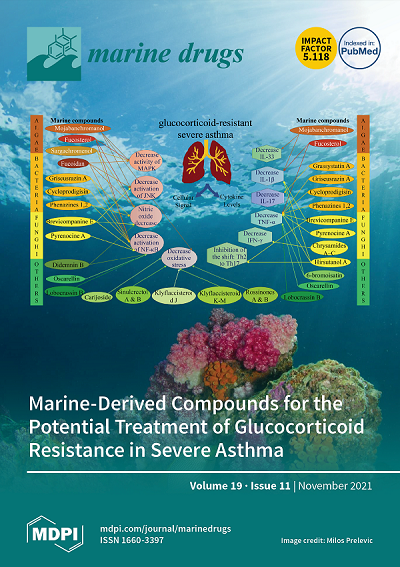海洋微藻类在压力诱导下产生生物活性氧化脂
IF 4.9
2区 医学
Q1 CHEMISTRY, MEDICINAL
引用次数: 0
摘要
微藻类源于复杂的进化过程,其新陈代谢组成受到进化历程的影响。它们有能力产生多种多不饱和脂肪酸(PUFA),与陆生植物和油性鱼类中的多不饱和脂肪酸相似。此外,由于这些新陈代谢化合物含有大量双键,很容易发生氧化过程,从而产生有价值的生物活性分子--氧脂素。此外,由于微藻对各种环境的适应性,它们为这些化合物的生物合成提供了一个令人感兴趣的途径。因此,改变培养条件可能会对草脂素的特征产生潜在影响。事实上,草脂素在微藻类中的积累受生长条件、营养供应和压力因素的影响,调整这些因素可以提高草脂素在微藻类培养中的产量。因此,本研究在不同的应激诱导条件(如引入 H2O2、EtOAc 和 NaCl)下,对在 1 升光生物反应器中培养的三种海洋微藻(两种跃层藻类和一种叶绿藻类)在其指数生长阶段的草脂素进行了 LC-MS/MS 分析。共鉴定出约 50 种氧脂素,其浓度因物种和生长环境而异。这项研究表明,通过改变培养条件,可以引导微藻的新陈代谢产生具有生物活性的氧脂。在这种情况下,对 Mi 124 施加低剂量的过氧化氢似乎能刺激非酶性氧脂的产生。对 Mi136 而言,施加盐胁迫似乎增加了草脂素的总体产量。对于 Mi 168,低浓度的 H2O2 或高浓度的 AcOEt 似乎都有这种效果。本文章由计算机程序翻译,如有差异,请以英文原文为准。
Stress-Induced Production of Bioactive Oxylipins in Marine Microalgae
Microalgae, stemming from a complex evolutionary lineage, possess a metabolic composition influenced by their evolutionary journey. They have the capacity to generate diverse polyunsaturated fatty acids (PUFAs), akin to those found in terrestrial plants and oily fish. Also, because of their numerous double bonds, these metabolic compounds are prone to oxidation processes, leading to the creation of valuable bioactive molecules called oxylipins. Moreover, owing to their adaptability across various environments, microalgae offer an intriguing avenue for biosynthesizing these compounds. Thus, modifying the culture conditions could potentially impact the profiles of oxylipins. Indeed, the accumulation of oxylipins in microalgae is subject to the influence of growth conditions, nutrient availability, and stressors, and adjusting these factors can enhance their production in microalgae culture. Consequently, the present study scrutinized the LC-MS/MS profiles of oxylipins from three marine microalgae species (two Haptagophytes and one Chlorophyte) cultivated in 1 L of photobioreactors under varying stress-inducing conditions, such as the introduction of H2O2, EtOAc, and NaCl, during their exponential growth phase. Approximately 50 oxylipins were identified, exhibiting different concentrations depending on the species and growth circumstances. This research suggests that microalgae metabolisms can be steered toward the production of bioactive oxylipins through modifications in the culture conditions. In this instance, the application of a low dose of hydrogen peroxide to Mi 124 appears to stimulate the production of nonenzymatic oxylipins. For Mi136, it is the application of salt stress that seems to increase the overall production of oxylipins. In the case of Mi 168, either a low concentration of H2O2 or a high concentration of AcOEt appears to have this effect.
求助全文
通过发布文献求助,成功后即可免费获取论文全文。
去求助
来源期刊

Marine Drugs
医学-医药化学
CiteScore
9.60
自引率
14.80%
发文量
671
审稿时长
1 months
期刊介绍:
Marine Drugs (ISSN 1660-3397) publishes reviews, regular research papers and short notes on the research, development and production of drugs from the sea. Our aim is to encourage scientists to publish their experimental and theoretical research in as much detail as possible, particularly synthetic procedures and characterization information for bioactive compounds. There is no restriction on the length of the experimental section.
 求助内容:
求助内容: 应助结果提醒方式:
应助结果提醒方式:


